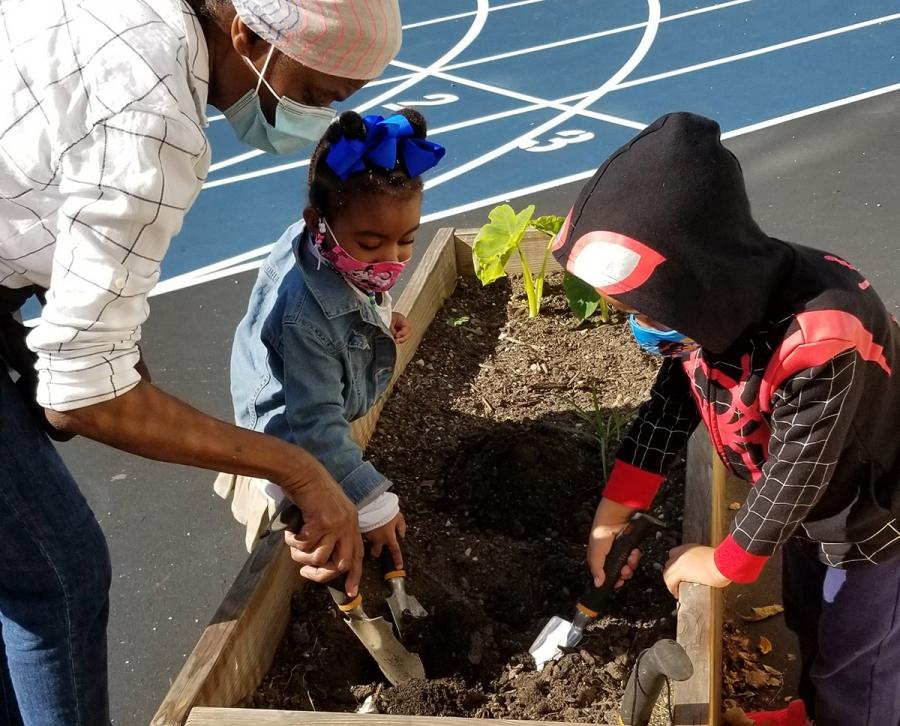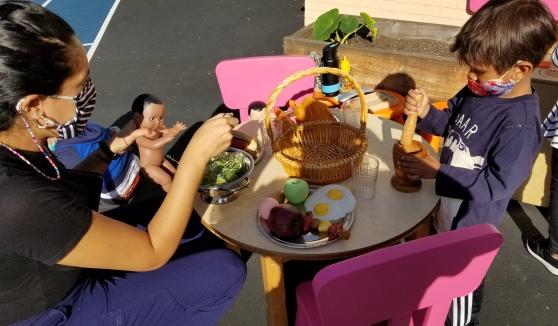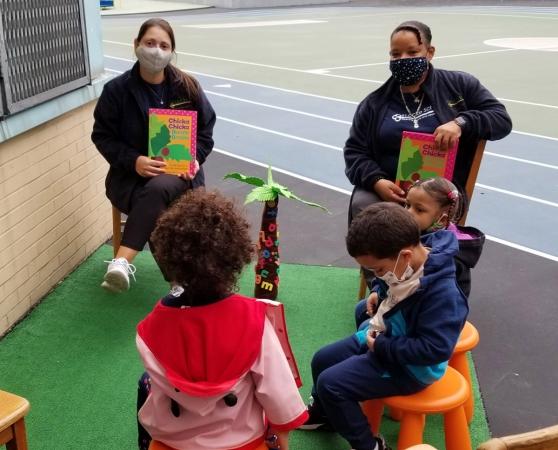It was a small but unforgettable moment in Renee Pearson’s outdoor pre-K class: a new student was about to pick a green tomato in the school garden but was dissuaded by a classmate. “It’s not red; it’s not ready yet,” the boy said.
Students teaching one another is just one of the gifts of the garden that grows behind PS 185/the Locke School of Arts and Engineering in Harlem.
Five months into the pandemic, the city encouraged schools to create outdoor classrooms. The staff at PS 185 jumped at the opportunity.
“Even before the pandemic, we had implemented outdoor learning on a smaller scale, using the garden during recess,” said Chapter Leader Kaitlyn Somerville.
Pre-K teachers have built a curriculum around the garden with the help of the school’s Green Team, parent advocates who wrote a proposal for city funding to create the kind of garden that could boost learning in areas such as science and vocabulary. “The pre-K team has been working with parents to make sure the curriculum is productive and can be implemented easily,” said Somerville.
From September until schools went fully remote on Nov. 19, PS 185 pre-K students spent as much time as possible outdoors, under the guidance of the pre-K team, which includes Pearson, Teresa Bello and Jacqueline Duran.
“Pre-K students are very social creatures,” Bello said. “They like to travel in little pods. The outdoors lends itself to distancing and a safe learning environment.”
In addition to tomatoes, the students grew Brussels sprouts and red chard. They collected the garden’s bounty in their own baskets, “an experience they wouldn’t have otherwise,” Pearson said.
Lavender and basil grew in the herb garden. The lavender was dried out to make scented oil, and the basil was used for pesto, giving students a chance to use their fine motor skills as they handle a mill or a mortar and pestle.
“It’s teaching them to love nature and the earth and make healthy food choices,” said Bello. “It’s a skill they’ll take with them throughout life.”
The outdoor classroom also develops stronger observational skills, said Duran, adding that she’s seen her young students “tracking an airplane through the sky.”
On warm days, the staff placed classroom furniture — including chairs and a kids’ play kitchen with a stove and refrigerator — outside. “It’s fun and exciting for them after being stuck at home, and it’s an opportunity to enjoy themselves,” said Duran.
Lunch was outdoors, and when the good weather held out, breakfast and snack time were outside, too.
Solis Nathy, a fully remote pre-K teacher, reinforced the garden lessons when students were learning from home. “They’re building vocabulary as they communicate about their new experiences,” said Nathy.
When the city approved their outdoor classroom at the end of August, Bello had to explain a few things to naysayers.
“When it’s raining, we stay inside,” said Bello. “When it’s 70 degrees in November” — like the warm spell that began the month — “we’re outside.”
Pre-K students have used the outdoor space most consistently, but students in kindergarten through grade 5 also used it for physical education and reading.
There’s a social-emotional component to the outdoors that can’t be discounted, said Bello. Students learn how fresh air can help them regulate their moods.
“If we’re stressed as adults, we go to the park and take a walk. It’s the feel of the sun on your face or hearing birds,” Bello said. For students, she added, the “experience of the outdoors takes them away from screens.”
For anyone creating an outdoor classroom, adaptability and flexibility are important, said Bello. The garden is going dormant in the cold weather, but the backyard can still be a place to learn. With the right clothing and boots, she said, there’s no reason why students can’t observe a snowy day up close and learn about the transformation of something from liquid to solid.
“It would be a wonderful way to learn science,” she said.


